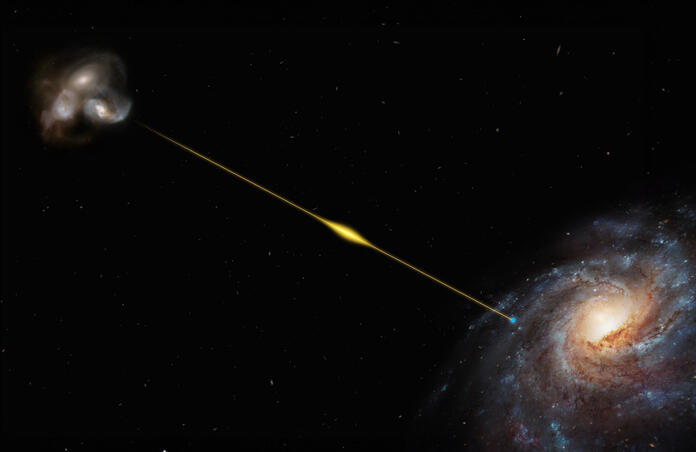Most distant radio burst yet could help find missing matter in the universe

The most distant and powerful fast radio burst (FRB) yet has been detected using the ASKAP radio telescope in Australia. The record-breaking radio pulse has travelled eight billion light years to get to us, originating from a time when the universe was younger than half its current age. The important discovery can provide insight into the matter content of the universe by revealing information on the cosmic environment the emission travels through.
FRBs are short pulses of radio emission, released from distant extragalactic sources. Currently the phenomenon is not very well understood, with little being known about what causes them. Initially, there were beliefs that such signals were a form of communication from extra-terrestrial life, since the pulses tend to repeat. However, scientists have since turned to magnetars as the source, far-away neutron stars with extremely powerful magnetic fields.
Previous studies of FRBs have uncovered the Macquart relation, where such phenomenon localised to host galaxies at different redshift display a positive relation with the extragalactic dispersion measure, the density of electrons the radio signal travels through as it traverses the intergalactic medium, and the host redshift. However, this correlation has only been measured using FRB host galaxies at nearby redshifts.
The extremely powerful FRB dubbed FRB 20220610A was discovered by scientists in June 2022. Although the signal lasted a mere thousandth of a second, it released the same amount of energy the sun emits over 30 years, also beating the previous record holder easily by 3 billion light years! "We were lucky to be looking at that little spot in the sky for that one millisecond after the eight billion years the pulse had traveled to catch it," said Ryan Shannon, astrophysicist at Swinburne and co-author of the study describing the find in the journal Science.
As explained by Shannon, there may be hundreds of thousands of FRBs lighting up the sky every day, however, only a thousand have been detected as of yet. Of those detected, scientists have been able to discover the origin of only 50, which is a key piece of the puzzle needed to understand this phenomenon. The team used the Very Large Telescope in Chile to uncover the origin of FRB 20220610A, determining that the bright flash came from a clumpy galaxy that may have been in the process of merging with a few other galaxies, subsequently birthing a powerful magnetar.
In addition to better understanding FRBs, scientists hope to utilise these bizarre objects as a tool for uncovering more about another large mystery of the cosmos- the seemingly ‘missing’ amount of normal matter. Although the universe consists of 5% normal matter, when all the stars and galaxies are counted up, over half is missing. Scientists believe that the rest is in filaments connecting galaxies together, comprising what is called the cosmic web. These filaments are so diffuse that current telescopes cannot see it. However, FRBs can help: “such pulses are imprinted with the signature of all the gas they travel through”, explains Shannon. Some FRB wavelengths are slowed down when the pulse travels through diffuse matter, therefore, radio waves with distinct frequencies reach ground-based telescopes at different times, providing the total weight of the universe. Nonetheless, this method will require the observation of hundreds of FRBs.
Hope is not lost, since more advanced radio telescopes are expected to go online soon. For example, the international Square Kilometer Array Observatory is building two radio telescopes that will be capable of detecting thousands of FRBs. Additionally, ESOs Extremely Large Telescope, currently under construction, will be able to study the source galaxies of FRBs even more distant than FRB 20220610A.
--
Cover image: ESO/M. Kornmesser
Journal source: S. D. Ryder et al, A luminous fast radio burst that probes the Universe at redshift 1, Science(2023). DOI: 10.1126/science.adf2678. www.science.org/doi/10.1126/science.adf2678
